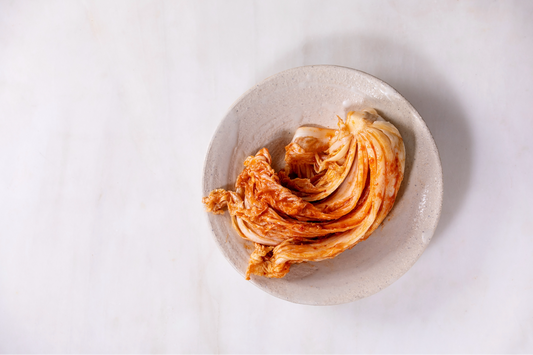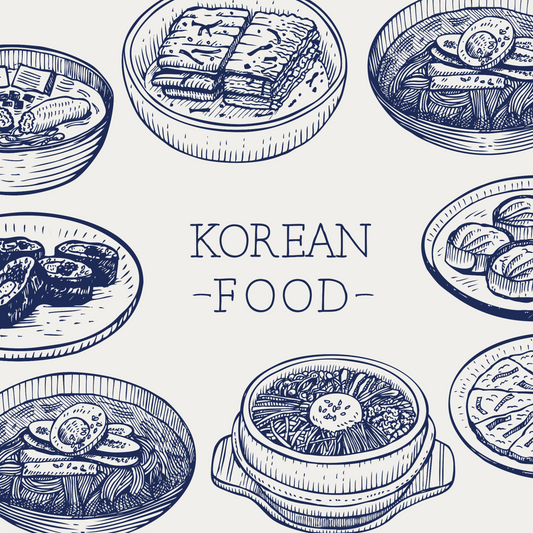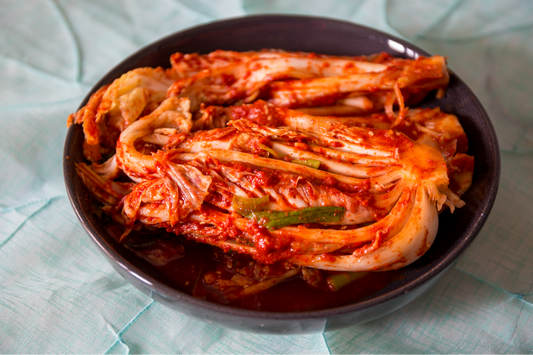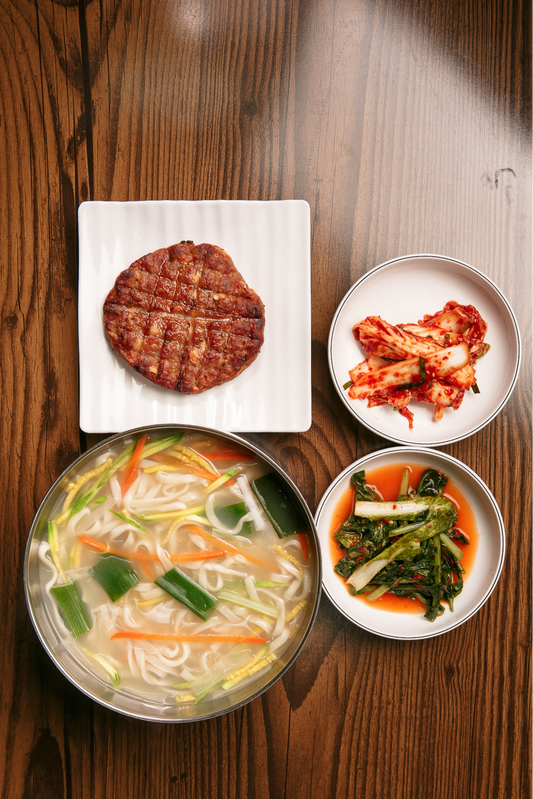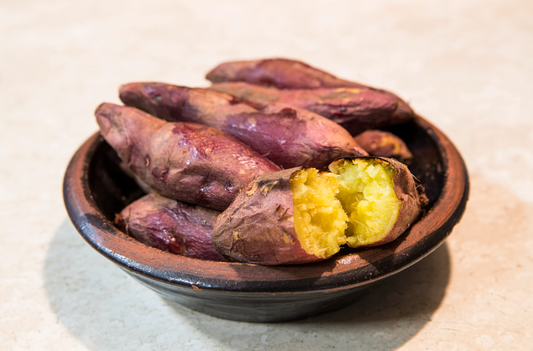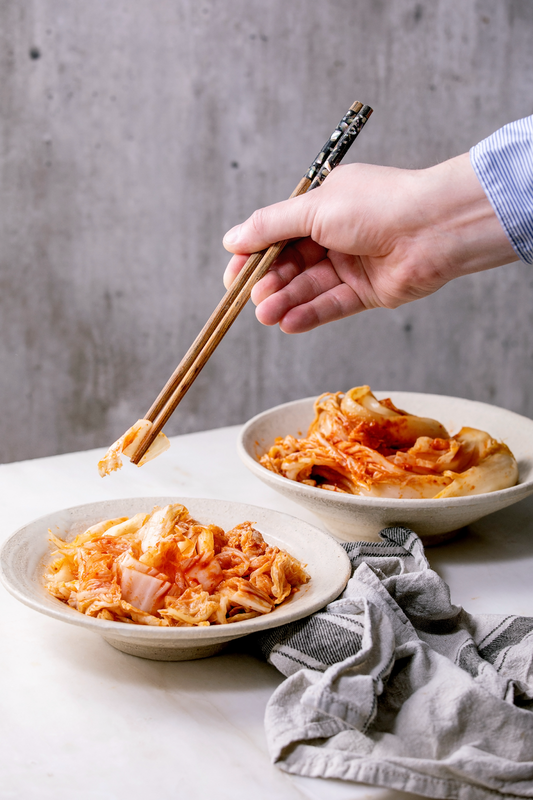Potatoes, Samgyeopsal, Juk, and Bibimbap: Enjoying Various Korean Dishes with Kimchi(part2)

Juk: The Comforting Smoothness of Rice Porridge with Kimchi
The soothing qualities of juk with kimchi are loved by many fans of Korean food. This dish, often seen as nurturing, uses the taste of kimchi to add vibrant contrasts. The creamy texture of rice porridge mixed with the bold flavors of kimchi and soft juk creates a special eating experience. It comforts and excites your taste buds at the same time.
Adding kimchi to juk boosts its flavors and nutritional value. It's found in fermented foods. This combination of kimchi's boldness with the creamy rice porridge makes a meal that's both hearty and satisfying. Juk with kimchi is perfect for breakfast or a light meal, showcasing the soul of Korean comfort food.
Variations of juk, like mung bean porridge highlighted by Maangchi, show its versatility. A mung bean recipe got over 300,000 views on YouTube, showing people's love for comforting dishes. This excitement is not just about one type but shows the wide appeal of kimchi with soft juk to many people.
Juk paired with kimchi is great for cold days or when you want something simple but filling. It offers a lovely mix of textures and keeps the delicate balance of comfort food. Gaining culinary respect, it celebrates the simplicity and depth of Korean food traditions around the world.
The Taste and Characteristics of Juk
Traditional Korean juk is well-loved for its smooth feel and comforting nature. It's a favorite for breakfast in Korea. This rice porridge comes in many forms. Each has a gentle taste and creamy feel. Juk is easy to eat for both young people and seniors, making it a nutritious choice.
Description of the mild, comforting taste of rice porridge, often served for breakfast
Korean juk is a great breakfast option because it's light and easy to digest. Its mild taste works well with bolder flavors. For example, it pairs nicely with kimchi and other sides like chili sesame paste and pickled beef. Juk can be made with different ingredients, including chicken, seafood, and ginseng. This flexibility lets it keep its comforting taste.
The love for traditional Korean juk has led to chains like Bon Juk in Seoul. These places meet the high demand for this comforting meal. You can find juk on many menus, from casual to fancy restaurants. It's perfect for a quick breakfast or a light, healthy dinner. Juk truly captures traditional Korean food culture.
Flavor Balance Between Juk and Kimchi
The combo of flavor harmony of juk and kimchi is a top example of Korean comfort food pairings. Juk's softness is enhanced by the bold, spicy taste of kimchi. It's a pairing that makes your taste buds happy and keeps Korean traditions alive.
How the bold flavors of kimchi enhance the delicate taste of juk, adding a refreshing element
Kimchi is famous for its health perks and intense flavor. It perfectly goes with juk's gentle taste. Baechu kimchi, the napa cabbage kimchi, adds a spicy and tangy kick. It makes juk even more comforting and enjoyable.
Juk and kimchi bring simple and complex flavors together. Juk is a go-to comfort food in Korea, especially when it's cold or when someone needs a pick-me-up. By adding different kinds of kimchi like Kkakdugi or Chonggak kimchi, juk turns into an exciting meal.
Kimchi doesn't just add flavor to juk; it takes it to a whole new level. This mix is a joyous celebration of tastes. It's key in Korean comfort food pairings. This combo welcomes everyone to try the amazing flavors of Korean cooking traditions.
Tips and Recipe for Pairing Juk with Kimchi
The combo of juk and kimchi recipe is a top pick for a hearty Korean dish. Juk is a Korean rice porridge that goes great with the lively taste of kimchi. This pair not only tastes wonderful but is also healthy, loved for regular meals and by those watching their diet.
Suggested ways to serve kimchi alongside different varieties of juk
Abalone and pumpkin juk are favorites for their great taste and health perks. Abalone juk, known for its sea flavor, matches well with spicy kimchi. The strong kimchi flavor mixes well with the smooth juk. Pumpkin juk's mild sweetness and creamy feel are made even better with kimchi, offering a fun taste mix.
If you're into keeping the classic tastes but want something new, try Pine Nut Porridge. It's made with short grain rice and pine nuts, giving a creamy and nutty taste. Adding kimchi turns each bite into a rich mix of gentle and zesty flavors.
Pine Nut Porridge, garnished with jujube, shows the rich tradition of Korean cooking and its focus on health and taste.
Exploring juk and kimchi recipe options can brighten the mild juk flavors. Whether it’s plain rice porridge or something fancier like abalone juk, kimchi adds an exciting twist. It turns a simple bowl into an exploration of Korean dish combinations.
To sum up, mixing different juk types with kimchi opens up classic Korean tastes and creativity in the kitchen. Choosing your favorite juk and kimchi pair lets you enjoy Korean cooking’s basics. It also lets you add your own touch.

Bibimbap: The Richness of Mixed Vegetables and Rice with Kimchi
The classic Korean dish, bibimbap, stands out for its vibrant colors, tastes, and textures. It looks great and is good for you too. It has rice, vegetables, protein, and a shiny egg on top. Spicy gochujang sauce adds a kick to every bite. Choosing and preparing the bibimbap kimchi recipe ingredients carefully is key.
What's great about bibimbap is you can switch it up. For veggies, try spinach, mushrooms, carrots, and cucumber with sesame oil and tamari. Vegans can swap the egg for tofu or tempeh. Don't forget the kimchi. It brings a spicy, tangy balance to the dish's rich tastes.
Making good bibimbap means focusing on balance. Cook the rice with a bit less water to keep it from getting mushy. This keeps its texture just right. Veggies should be cooked just enough to taste great and feel good in the mix.
“Bibimbap is not only a feast for the taste buds but also for the eyes, with its vibrant array of colors and arrangement of toppings elaborately presented to delight the senses,” notes a culinary expert.
This dish is a perfect example of Korean cooking's focus on harmony and balance. It mixes different veggies and proteins to create a complete meal. The care in making it and the way it's enjoyed show how important bibimbap is in Korean food. Changing the bibimbap kimchi recipe to fit what you like doesn't take away from its unique appeal.
The key to great bibimbap with kimchi is mixing all parts well—spicy, savory, and fresh. It's both healthy and tasty. More and more people are falling in love with bibimbap and kimchi pairing. This shows the rich food culture of Korea.
The History and Types of Bibimbap
The traditional Korean dish bibimbap shows the beauty of Korean culinary heritage. It combines many ingredients and flavors, coming from rich cultural beginnings. Originally for royalty, it's now loved by everyone. It brings together five elemental colors to represent balance in the universe—white, black, red, yellow, and green.
Different types of bibimbap come from various parts of South Korea, each telling its own story. In the U.S., Jeonju bibimbap is very popular. It comes from South Western Korea and uses rich ingredients like beef bone broth. It might include up to 30 different items, such as ginkgo nuts and dates.
Then there's Jinju bibimbap, born during hard times. It has unique items like raw beef and sweet sauce. This shows how the history of a region can affect its food.
Seasonal & Regional Diversity
What bibimbap you get can depend on the season. Miss Kim’s, for example, offers special versions like the winter Haejoo bibimbap. Or the autumn Yeolmu bibimbap that has young radish kimchi. Coastal areas have hoedeopbap, mixing raw fish with vegetables. This shows bibimbap's ability to adapt to local tastes and seasonal foods.
At its core, bibimbap has rice topped with veggies, meats, and gochujang (chili pepper paste). It's carefully arranged for beauty and balance. This attention to detail makes bibimbap a global favorite, seen in international flights and ad campaigns. It's a true symbol of Korean food culture worldwide.
Bibimbap mixes tradition with new ideas, constantly evolving. It's a nod to both old and modern Korean food ways. You can find it everywhere, from simple kitchens in Korea to fancy restaurants worldwide. Bibimbap shows the lasting impact of Korean culture on world cuisine.
Flavor Combination of Bibimbap and Kimchi
Bibimbap and kimchi together create a taste adventure. It shows the skill of the Korean kitchen in mixing flavors and nutrition. This combination is not just tasty but also good for you. It looks as great as it tastes. With rice, kimchi, many veggies, and a special sauce, each bite of bibimbap is amazingly delicious.
How kimchi enhances the layered flavors of bibimbap, adding spice and depth to each bite
Kimchi adds more than just spice to bibimbap; it takes the flavors to a new level. The tangy taste of kimchi mixes well with the veggies and the sauce's richness. It makes the meal more enjoyable. The sesame oil, red pepper paste, and veggies in bibimbap taste even better with kimchi's zing. This combo doesn't just taste great; it's also healthier because of kimchi's good bacteria.
People who love bibimbap and kimchi say kimchi brings out the flavors of the other ingredients. It adds a crunch that goes well with the soft rice and veggies. This shows Korean food's magic in making meals that celebrate culture and new cooking ideas.
Tips and Recipe for Pairing Bibimbap with Kimchi
Exploring Korean cuisine begins with making bibimbap and kimchi. This journey introduces you to traditional flavors and textures. You get an authentic taste of Korea by mixing fresh ingredients with kimchi's tang. While preparing Beef Bibimbap, remember to marinate the lean beef. Use a tasty mix of ingredients and cook it just right.
Seamlessly Infusing Kimchi for a Flawless Finish
Creating a great bibimbap is about the cooking and presentation of each part. Start with jasmine rice on the bottom. Then, add marinated beef, spinach, carrots, and cucumber. If you're avoiding eggs, just highlight the kimchi instead. Warm the kimchi in a dolsot if you can. This makes its flavor even better, matching perfectly with the beef and veggies.
To elevate the dish, sprinkle sesame seeds and a bit of sesame oil. For more flavor, include gochujang, a Korean spice that fits well with kimchi. This bibimbap recipe serves four. It's rich in taste, offering protein, carbs, and crunch. Enjoy it with Cabernet Franc for a truly memorable meal. Every bite reflects deep Korean culinary traditions. It's guaranteed to satisfy, rating 4.78 out of 5.
FAQ
What dishes pair well with kimchi in Korean cuisine?
Kimchi pairs well with many Korean dishes. These include gamjatang, samgyeopsal, juk, and bibimbap. The spice and acidity of kimchi balance and enhance their flavors.
How does kimchi complement the flavor of potatoes?
Kimchi offers a spicy and acidic contrast to the simple taste of potatoes. This balance showcases the complex flavors in Korean cuisine.
Can you describe the taste of samgyeopsal and why it pairs well with kimchi?
Samgyeopsal has a rich, fatty flavor with a crispy texture. Kimchi's spicy and acidic qualities cut through the meat's richness. This creates a balanced and harmonious pairing.
What are the benefits of adding kimchi to juk?
Adding kimchi to juk makes it more flavorful and invigorating. The sharpness of kimchi refreshes the mild porridge.
How can I incorporate kimchi into bibimbap?
Kimchi adds spice and complexity to bibimbap. Mix it in or serve on the side. Warm the kimchi in a dolsot to enhance its flavors.
What is the best way to enjoy potatoes with kimchi?
To enjoy potatoes with kimchi, pair them in dishes like gamjatang. Or, serve kimchi with boiled or roasted potatoes as a side.
Can you offer tips for grilling samgyeopsal and serving it with kimchi?
Grill samgyeopsal until crispy outside and juicy inside. Serve with various kimchi types for flavor. Add sides like lettuce, garlic, and ssamjang.
What are some ways to serve kimchi with juk?
Serve kimchi as a side with juk. Pair it with different juk varieties for a dynamic flavor. The zest of kimchi contrasts well with rich or sweet juk.
What should I consider when pairing bibimbap with kimchi?
Balance flavors when pairing bibimbap with kimchi. The spice and acidity of kimchi enhance the dish. Warm the kimchi and mix well.
What are some traditional Korean dishes that feature both potatoes and kimchi?
Traditional dishes like gamjatang combine potatoes and kimchi. Potato-based sides with kimchi's kick highlight Korean cuisine's earthy and tangy flavors.





